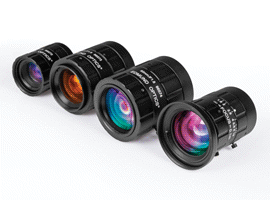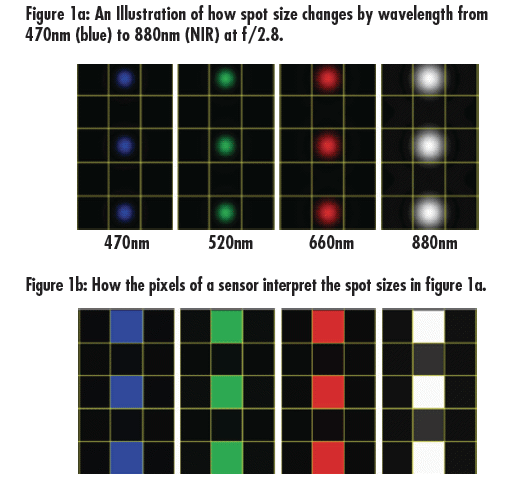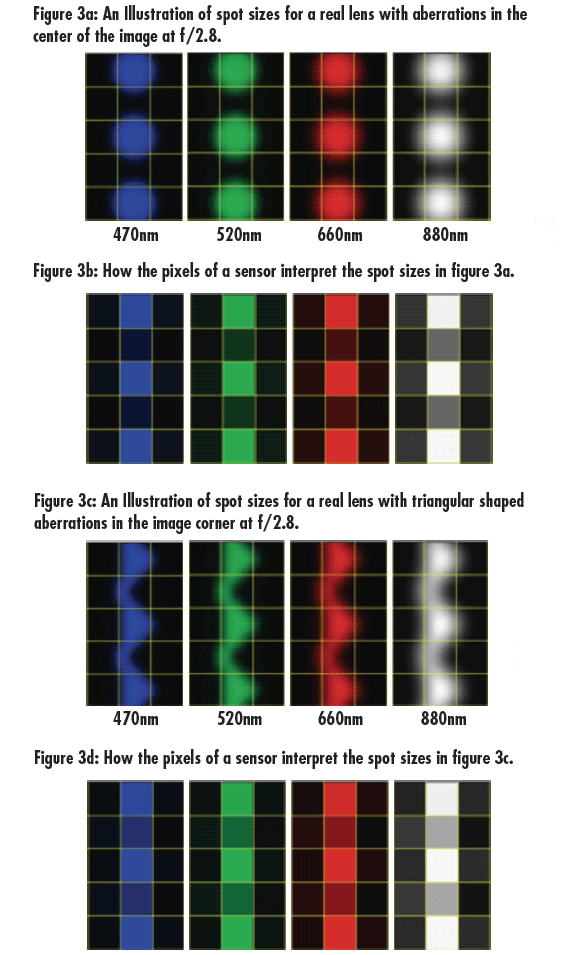From Lens to Sensor: Limitations on Collecting Information
Auteurs : Gregory Hollows, Nicholas James

In an effort to better understand the differences that can occur between theoretical and as-manufactured performance, Examples 1-3 show what happens at the sensor level, and how output from the sensor would be visualized with different wavelengths and f/#s. Figures transition from theoretical to real world examples that include aberration and lens fabrication errors.
As will be noted, the shorter the wavelength, the theoretically greater the performance of the imaging system. In recent years, blue LEDs have become very dependable for increasing the performance of small pixel-equipped sensors. Remember Edmund Optics Best Practice #5, Color Matters. Understanding the physical capabilities and limitations of a lens at different f/#s and wavelengths helps the user optimize the utility of high resolution imagers and enables solutions to once difficult applications.
Example 1: Variation in Spot Sizes and Pixel Outputs with Wavelength at Low f/# (Theoretical)
Figures 1a and 1b demonstrate four different wavelengths being perfectly imaged, with the exception of blur caused by diffraction (Diffraction Limit), in the center of a sensor containing 3.45μm pixels and at f/2.8. This is considered a small pixel size, and it is associated with a very popular 5 MegaPixel sensor utilized by many camera companies. Figure 1a shows the difference in spot size when stepping up from 470nm (Blue) to 880nm (NIR) wavelengths. Figure 1b shows pixel outputs for each of the images created by the lens in Figure 1a; notice the smaller spots associated with the shorter wavelengths.

Figure 1: Variation in Spot Sizes and Pixel Outputs with Wavelength at Low f/#
Example 2: Variation in Spot Sizes and Pixel Outputs with Wavelength at High f/#s (Theoretical)
The images in Figure 2 is similar to Figure 1, but the aperture setting has been changed to f/8. At this setting, Figure 2a shows that all of the spots, regardless of wavelength, exceed the size of a single pixel, which causes energy to spill into adjacent pixels. Figure 2b shows a noticeable blurring in the pixel outputs at the longer wavelengths with spots at 880nm no longer able to be separated. This demonstrates the physical ramifications associated with changing the f/#, even in a theoretically perfect system.

Figure 2: Variation in Spot Sizes and Pixel Outputs with Wavelength at High f/#
Example 3: Variation in Spot Sizes and Pixel Outputs with Wavelength in Real Lenses That Include Aberrations
In this example, a more realistic representation of the center and corner of a true lens design is shown at f/2.8. These figures now include aberrations that are inherent in even the highest quality lens designs, as well as issues associated with manufacturing tolerances. Aberrations misplace information and alter the shape of the spots that are created, leading to shapes that are no longer rotationally symmetric; the sum of all aberrations involved determine this shape. Please note, aberrations tend to be more pronounced at the corner of an image than compared to the center. A great difference can be seen between the spots shown in Figures 1a and 1b versus Figures 3a and 3b; Figure 1 is a theoretical demonstration, while Figure 4.3 uses a real lens. Notice how aberrations influence the spot shapes image shown in Figure 3c and 3d.

Figure 3: Variation in Spot Sizes and Pixel Outputs with Wavelength in Real Lenses that include Aberrations
Example 4: Real-World Lens Performance. Looking at Actual Images.
Figure 4 is an application image that shows the difference in real-world performance of two lenses with the same focal length (16mm), f/# (2.8), and field of view (100mm horizontally) coverage. These images demonstrate all of the concepts detailed in the sections in MTF, f/#, and wavelength. The target is a multielement Star Target (#58-835) that allows the concurrent visualization of a wide range of frequencies (resolutions) in all areas of the FOV and in all directions. More details on this and other targets for benchmarking a systems performance can be found in application note, Choosing the Correct Test Target.

Figure 4: A Star Target is Imaged with Two Lenses (A and B) with the same Focal Length, f/#, Field of View, and Sensor. The superiority of Lens A is apparent in all areas but is most pronounced along the edge and in the corner of the image
The differences in lens performance can be seen by examining closeup sections of the field of view (full resolution images available online). Figure 4 shows the complete star target; the highlighted areas located in the center, bottom middle, and the corner of the target will be compared between the two different lenses. A Sony ICX625 monochrome sensor with 3.45μm pixels and a total resolution of 5 MegaPixels and a white light back light illuminator are used in this example. The comparisons shown in Figure 4 demonstrate Lens A’s superior performance. Specifically, the corner of the image shows a large difference in contrast, as it is noticeably more difficult to differentiate the blacks and whites in the Lens B example. Additionally, the directionality of different aberrations (mainly astigmatism) are prominent; more detail can be seen associated with lines propagating in the radial direction.
The close up of the corner of the image in Figure 4 (yellow and red boxes) presents an additional concern, where each black and white line pair covers approximately 10 pixels total. Compared to the resolvable portion at the center of the image, the corner has effectively reduced spatial resolution (due to the blur circle covering multiple pixels) from 5 MegaPixels (2448 x 2050) near the center to approximately 500 x 400 pixels in the corner, which is below what a VGA sensor (640 x 480 pixels) can reproduce. Even at reduced sensor resolution, some lenses will still struggle greatly due to design constraints and manufacturing tolerances, which is demonstrated by the different contrast levels from each lens. For instance, the contrast level in the yellow box for Lens A Figure 4: is 45% and 7% in the red box for Lens B.


























ou consulter les numéros d’autres pays
facile à utiliser
entrer les numéros de stock pour commencer
Copyright 2023 | Edmund Optics, Ltd Unit 1, Opus Avenue, Nether Poppleton, York, YO26 6BL, UK
L'entreprise Edmund Optics GmbH en Allemagne agit comme un mandataire d'Edmund Optics Ltd au Royaume-Uni. Le titulaire du contrat est Edmund Optics Ltd au Royaume-Uni.